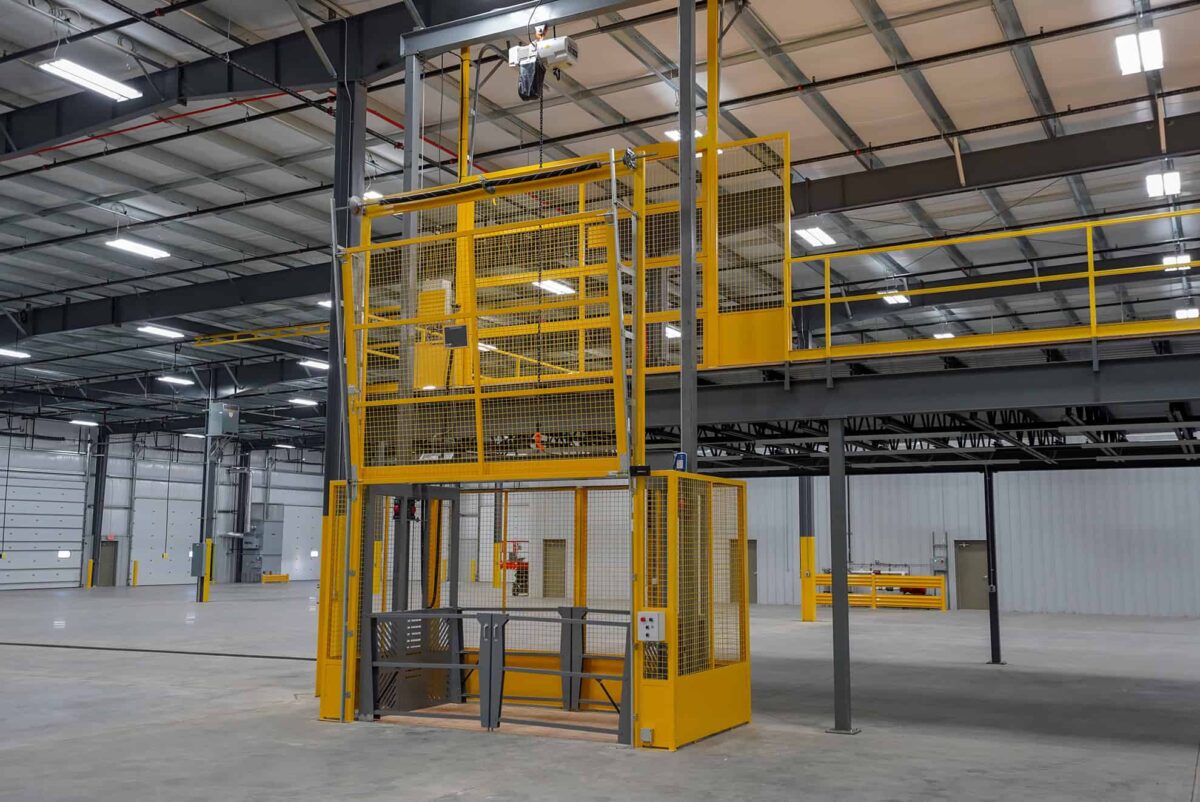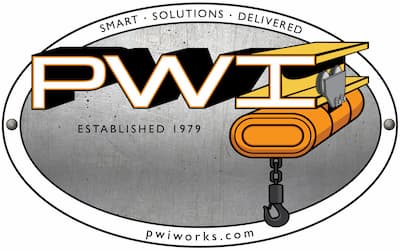If you need to lift material up to a mezzanine floor, what solution would you choose? A forklift, mezzanine lift, freight elevator, or even manually carrying it? These may all be options that work, but only one is the best solution.
Lifting a load up to a mezzanine floor can present many challenges. Depending on the load weight and how often loads need to be lifted, there are a number of options to choose from.
You could use a forklift and access gate, install a VRC (Vertical Reciprocating Conveyor), or even carry the material manually. These are all possible options, but they each have drawbacks that can be costly and potentially dangerous.
Fortunately, we are going to clear up the pros and cons of each system and explain why one of them is still by far the best solution.
Manually Carry Material Up Stairs
Carrying material manually up the stairs to a mezzanine floor is arguably the quickest and most reliable way to transport a lightweight load. But within a work area, safety is far more important than speed.
OSHA does not have specific regulations regarding the manual lifting of loads, but the National Institute for Occupational Safety and Health (NIOSH) has developed a mathematical model that helps predict the risk of injury.
The NIOSH lifting equation establishes a maximum of 51 pounds that is then adjusted for these factors:
- How often are you lifting the object?
- Do you bend or twist while lifting?
- To what height is the object lifted?
- Where is the origin of the lift?
- How close the object is to you while lifting?
- How long do you lift or hold the object?
- How easily can you hold onto the object?
A combination of these factors results in an object that is safe to lift in one instance but with the potential to cause injury in another. This could explain why the guidelines are, in fact, voluntary.
So, while there is no specific regulation preventing your employees from manually carrying loads up to a mezzanine, it is important to remember that under Section 5(a)(1) of the OSH Act—aka the General Duty Clause—each employer must provide a place of employment free from recognized hazards that can or are likely to cause serious physical harm or death.
Manually carrying a load falls very much within this area.
If you consider the likelihood of physical exhaustion, injury, or worse, it is clear that manually carrying a load to a mezzanine floor is not a viable or sustainable solution.
Forklift

A forklift has a number of advantages. It isn’t physically demanding, is relatively safe, and many workspaces already have one.
But that doesn’t make it the best solution for lifting loads to a mezzanine. Why?
- The space involved in maneuvering a forklift
- The availability and coordination that is required to get it when it’s unused
- Safety concerns
If your mezzanine deck is higher, using a forklift could potentially be very dangerous. That’s because the width of the load or alignment can easily cause the load to fall from the forks.
Another problem with forklifts is that they can easily (and often) cause damage to the side of the mezzanine by gauging or knocking it with the forks. Even the most skilled forklift driver will have an off day that could result in a damaged structure.
Forklifts aren’t cheap either. If your site does not already have one, it is likely to set you back at least $25,000, and the annual maintenance cost can be between $500-1,500 based on an average single-shift operation. You could expect a forklift to last about 10-20,000 hours depending on the brand, giving you a 10-year average life span.
In spite of the drawbacks, many workspaces do still use a forklift to lift loads to a mezzanine floor. If it is the only solution for your site, remember that you will also need to install a safety pallet gate. This is a section where the guardrails can be opened to allow for the loading of pallets.
VRC Material Lift

Now onto what we believe is the best solution for lifting loads to a mezzanine floor.
A Vertical Reciprocating Conveyor (VRC) is designed for this specific purpose. It is a self-contained structure that sits flush alongside your mezzanine floor meaning that it will not add any strain to your mezzanine or building structure. This makes it an incredibly safe solution for lifting very heavy loads even up to 3.5 tons.
These safety benefits do come with a slight drawback which is a slower transition time from floor to floor. You can expect it to travel at only 10-20 FPM (Feet Per Minute). This may seem slow compared to a forklift and manually carrying the load, but the reliability, safe operation, and load capacity balance out this concern.
While a VRC Material Lift is the best investment in terms of safety and capacity, it is also a significant investment financially. You can expect to pay anywhere from $50,000 – $100,000 for a VRC and an annual maintenance cost of around $1,000. With sufficient maintenance and standard use, a VRC can easily last 20+ years making it a valuable—albeit expensive—long-term investment for your workplace.
The problem with a mezzanine lift and freight elevator
Another important consideration is that it is not permitted for a person to ride in a vertical reciprocating conveyor. This is, in part, referenced in the name. Typically the words “mezzanine lift” or “freight elevator” will come to mind for this type of system, but they are designed also for a person to travel with the load. This presents additional safety hazards and unsurprisingly a significant increase in cost.
OSHA considers the riding of vertical reciprocating conveyors by employees to be in violation of 29 CFR 1910.212(a)(1) because the safety of personnel cannot be assured. However, if your VRC Material Lift meets the criteria of ANSI A17.1, OSHA would reevaluate this position relative to such specific installations.
Honorable Mention: Overhead Cranes
Overhead cranes are another good solution to lifting loads up to a mezzanine floor. They are very safe and can manage heavy loads with ease. While they do not have the self-contained structure of a VRC, objects that need to be lifted can be placed in a container for an overhead crane to maneuver.
The only real issue is that while they are suitable, they are also a little excessive mainly due to the structural demands of installing them. Depending on the height of your mezzanine relative to the height of your building, they may also not be viable because of clearance.
The cost is also a big consideration as overhead cranes are among the most expensive option for lifting loads, although this is offset by a very long life span.
What Should I Choose?
To make things a little simpler to understand, let’s break it down into the important categories that a production manager needs to consider:
Safety
PWI Material Lift VRCs have been designed to meet OSHA for material hoists and they all come with the Starke Secondary Brake device. In the unlikely event of a fall, this will act as a secondary stopping device reducing any risk of injury and damage to the load.
As mentioned before, a further benefit of a VRC Material Lift is that they are not designed to carry people which means fewer safety inspections and more manageable consequences in the event of something going wrong.
Cost
When considering the cost of any lifting solution, it is important to account for three factors:
- The weight of the load being transferred
- Transfer intervals
- Safety features
In each case as the requirements and demands of these criteria increase, the cost of a system will generally increase. With safety, as the cost of the lifting system increases, it will usually yield greater advantages in safety that will save a plant manager more in the long run than the initial costs.
VRC Material lifts are extremely reliable and typically wear is never an issue. They only require a small degree of maintenance to function properly. Some plant managers prefer to opt for a mechanical VRC which has a higher initial cost but lower maintenance costs.
Reliability
With regards to maintenance and reliability, a mechanical VRC is a very strong contender thanks to its simplicity. In fact, a mechanical VRC is likely to require the least maintenance of all solutions presented here including a forklift.
However, choosing the mechanical option is only appropriate when you can guarantee that the person performing the lifting is healthy and the load is light.
PWI VRCs are built using electric hoists because they provide a smoother lift and increased efficiency compared to a hydraulic or mechanical hoist. The lifting process is easily repeatable without overloading the system making it highly reliable, and maintenance is far simpler and less frequent than you can expect from a hydraulic lift.
PWI designs, fabricates, and installs material lift VRCs for mezzanines across the United States. Call (574) 646-2015 to talk to a mezzanine expert or submit a request for a quote and one of our team members will reach out to you.


![New Construction vs Mezzanine [PDF]](https://pwiworks.com/wp-content/uploads/new-construction-vs-mezzanine-pdf-464x600.jpg)